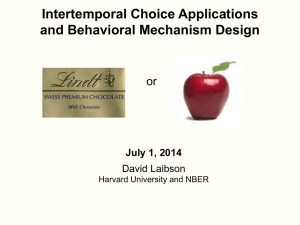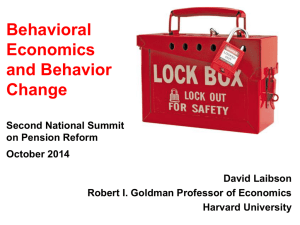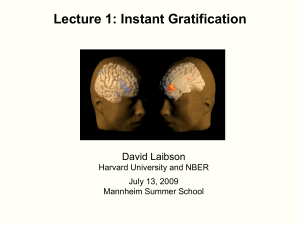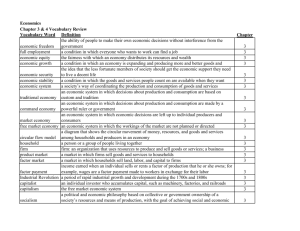Household finance
advertisement
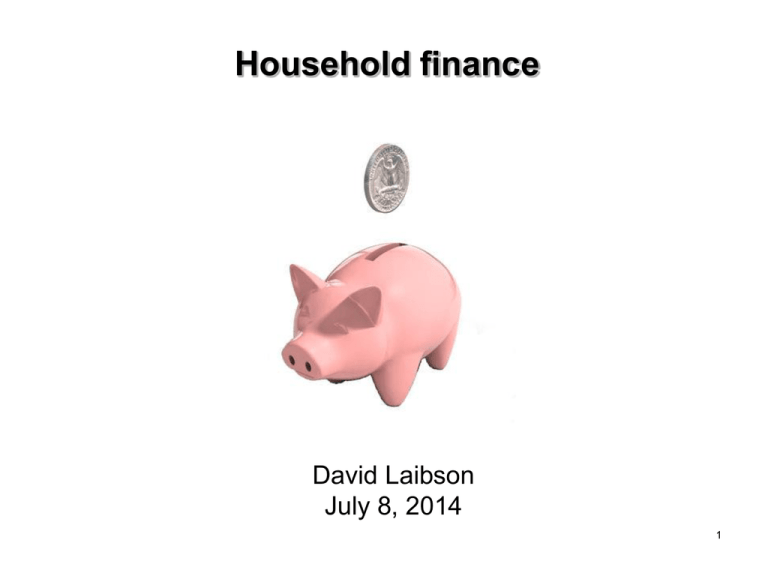
Household finance David Laibson July 8, 2014 1 Nine claims about household finance Households: 1. Have low levels of financial literacy 2. Have very few liquid assets (live hand to mouth) 3. Have substantial illiquid wealth 4. Have a high MPC out of liquid wealth and liquidity 5. Have a low MPC out of illiquid wealth 6. Don’t choose optimal financial service products 7. Barely change their behavior after financial education interventions 8. Have misaligned financial intentions and financial actions 9. Make financial choices that are easy to manipulate Nine claims about household finance Households: 1. Have low levels of financial literacy 2. Have very few liquid assets (live hand to mouth) 3. Have substantial illiquid wealth 4. Have a high MPC out of liquid wealth and liquidity 5. Have a low MPC out of illiquid wealth 6. Don’t choose optimal financial service products 7. Barely change their behavior after financial education interventions 8. Have misaligned financial intentions and financial actions 9. Make financial choices that are easy to manipulate Assessing Literacy: Numeracy Compound Interest “Suppose you had $100 in a savings account and the interest rate was 2% per year. After 5 years, how much do you think you would have in the account if you left the money to grow?” i) More than $102; ii) Exactly $102; iii) Less than $102; iv) Don’t know (DK); v) Refuse to answer. Source: Annamarai Lusardi Assessing Literacy: Inflation Inflation “Imagine that the interest rate on your savings account was 1% per year and inflation was 2% per year. After 1 year, would you be able to buy with the money in this account:” i) More than today; ii) Exactly the same; iii) Less than today; iv) DK; v) Refuse to answer. Assessing Literacy: Risk Diversification Risk Diversification “Do you think the following statement is true or false? Buying a single company stock usually provides a safer return than a stock mutual fund.” i) True; ii) False; iii) DK; iv) Refuse to answer. How much do older people (ages 50+) know? 34% correctly answer all 3 questions 40.00% 30.00% 40.00% 30.00% 20.00% 30.00% 20.00% 10.00% 20.00% 10.00% 0.00% Percent answering risk 10.00% diversification 0.00% correctly 43.40% Elementary 0.00% Less than HS 30.70% Less than HS Less HS High than School 50.40% High School Financial Literacy and Education 100.00% 90.00% 80.00% 70.00% 60.00% 50.00% 40.00% Less than HS High School Some College High School 56.70% Some College Some Some College + College 70.20% College + College + CollegeCollege + 30.00% 20.00% 10.00% 0.00% Source: Health and Retirement Study, 2004 30.7 30.70 50.4 50.40 56.7 56.70 70.2 70.20 Financial Literacy among the Young (23-27). NLSY: Percentage of correct responses Interest rate: 79.2% Inflation: 53.9% Risk diversification: 46.6% “If the chance of getting a disease is 10 percent, how many people out of 1,000 would be expected to get the disease?” Fraction of people who answer “100” Source: HRS; Agarwal, Driscoll, Gabaix, Laibson (2009) “If 5 people all have the winning numbers in the lottery and the prize is two million dollars, how much will each of them get?” Fraction of people who answer “400,000” Source: HRS; Agarwal, Driscoll, Gabaix, Laibson (2009) Nine claims about household finance Households: 1. Have low levels of financial literacy 2. Have very few liquid assets (live hand to mouth) 3. Have substantial illiquid wealth 4. Have a high MPC out of liquid wealth and liquidity 5. Have a low MPC out of illiquid wealth 6. Don’t choose optimal financial service products 7. Barely change their behavior after financial education interventions 8. Have misaligned financial intentions and financial actions 9. Make financial choices that are easy to manipulate Households live hand to mouth Lusardi and Tufano (2009) How confident are you that you could come up with $2,000 if an unexpected need arose within the next month? – I am certain…I could 47% – I could probably… – I probably could not… – I am certain…I could not 53% – Do not know. 23 65-74 year old households Survey of Consumer Finances In 2007, the median holding of financial assets including personal retirement accounts is $68,100 25 (Poterba, Venti, and Wise 2013; HRS 2008 wave) High MPC’s out of liquid wealth Shapiro (2005) • For food stamp recipients, caloric intake declines by 10-15% over the food stamp month. • To be resolved with exponential discounting, requires an annual discount factor of 0.23 = exp −1.47 . • Survey evidence reveals rising desperation over the course of the food stamp month, suggesting that a high elasticity of intertemporal substitution is not a likely explanation. • Households with more short-run impatience (estimated from hypothetical intertemporal choices) are more likely to run out of food sometime during the month. High MPC’s out of Social security Mastrobuoni and Weinberg (2009) • Individuals with substantial savings smooth consumption over the monthly pay cycle • Individuals without savings consume 25 percent fewer calories the week before they receive SS checks relative to the week after Lifecycle simulations (Angeletos et al 2001) • • • • • • • • Mortality Dependents Retirement/Social Security Three educational groups: NHS, HS, COLL Stochastic labor income Credit limit: (.30)(permanent income) 3 state variables: liquid and illiquid wealth, income. 2 choice variables: liquid and illiquid wealth investment Preferences • Constant relative risk aversion = 2 • For exponential discounting economy: β=1 δ=0.94 (match median ‘W/Y’ of 3.9 ages 50-59) • For quasi-hyperbolic discounting economy: β=0.7 δ=0.96 (match median ‘W/Y’ of 3.9 ages 50-59) Predictions (HS education) Exponential Hyperbolic % with at least 1 month of 73% 40% income in liquid assets liquid assets 0.50 0.39 mean Data 42% 0.08 total assets % with revolving credit 19% 51% 70% mean credit card borrowing $900 $3408 >$5000 MPC out of predictable movements in income 0.03 0.17 0.23 Laibson, Repetto, and Tobacman (2012) Use MSM to estimate discounting parameters: – Substantial voluntarily accumulated illiquid wealth: W/Y = 3.9. – Extensive credit card borrowing: • 68% didn’t pay their credit card in full last month • Average credit card interest rate is 14% • Credit card debt averages 13% of annual income – Consumption-income comovement: • Marginal Propensity to Consume = 0.23 (i.e. consumption tracks income) LRT Results: Ut = ut + b [dut+1 + d2ut+2 + d3ut+3 + ...] b = 0.70 (s.e. 0.11) d = 0.96 (s.e. 0.01) Null hypothesis of b = 1 rejected (t-stat of 3). Specification test accepted. …. have a low MPC out of illiquid wealth • Because households have little liquid wealth, and the illiquid wealth is hard to access • Though note that illiquid assets sometimes become liquid in large lumps (e.g., cash-out refinancing) • Also, note that idiosyncratic wealth shocks to illiquid retirement savings accounts lead agents to increase their savings rate (Choi, Laibson, Madrian, Metrick 2009) – Return chasing effect Nine claims about household finance Households: 1. Have low levels of financial literacy 2. Have very few liquid assets (live hand to mouth) 3. Have substantial illiquid wealth 4. Have a high MPC out of liquid wealth and liquidity 5. Have a low MPC out of illiquid wealth 6. Don’t choose optimal financial service products 7. Barely change their behavior after financial education interventions 8. Have misaligned financial intentions and financial actions 9. Make financial choices that are easy to manipulate Financial illiteracy in mutual fund choice Choi, Laibson, Madrian (2011) Subjects allocate $10,000 among four funds Randomly choose two subjects to receive any positive portfolio return during the subsequent year Eliminate variation in pre-fee returns Choose among S&P 500 index funds Unbundle services from returns Experimenters pay out portfolio returns, so no access to investment company services We conducted one version with Harvard staff as subjects 400 subjects (administrators, faculty assistants, technical personal, but not faculty) We give every one of our subjects $10,000 and rewarded them with any gains on their investment $4,000,000 short position in stock market 49 Data from Harvard Staff $581 Control Treatment $516 $518 $451 $385 $320 $255 3% of Harvard staff in Control Treatment put all $$$ in low-cost fund Fees from random allocation $431 50 Data from Harvard Staff $581 $516 $451 $385 $320 $255 Control Treatment Fee Treatment $518 $494 3% of Harvard staff 9% of Harvard staff in Fee Treatment in Control Treatment put all $$$ put all $$$ in low-cost fund in low-cost fund Fees from random allocation $431 51 $100 bills on the sidewalk Choi, Laibson, Madrian (2009) Employer match is an instantaneous, riskless return on investment Particularly appealing if you are over 59½ years old Have the most experience, so should be savvy Retirement is close, so should be thinking about saving Can withdraw money from 401(k) without penalty We study seven companies and find that on average, half of employees over 59½ years old are not fully exploiting their employer match Average loss is 1.6% of salary per year Educational intervention has no effect Social marketing and peer effects Beshears, Choi, Laibson, Madrian, Milkman (2014) 59 How does information about your peers affect savings behavior? Variation in peer information has no net impact on savings behavior Small perverse effects for unionized workers Small positive effect for non-unionized workers Sources of variation of peer information: Exclusion vs. inclusion of peer information Variation in peer success (due to variation in comparison group) All sources of variation generate consistent findings. Nine claims about household finance Households: 1. Have low levels of financial literacy 2. Have very few liquid assets (live hand to mouth) 3. Have substantial illiquid wealth 4. Have a high MPC out of liquid wealth and liquidity 5. Have a low MPC out of illiquid wealth 6. Don’t choose optimal financial service products 7. Barely change their behavior after financial education interventions 8. Have misaligned financial intentions and financial actions 9. Make financial choices that are easy to manipulate Procrastination in retirement savings Choi, Laibson, Madrian, Metrick (2002) Survey Mailed to 590 employees (random sample) 195 usable responses Matched to administrative data on actual savings behavior Typical breakdown among 100 employees Out of every 100 surveyed employees 64 68 self-report saving too little 24 plan to raise savings rate in next 2 months 3 actually follow through Credit card pay down Kuchler (2013) Data from on-line financial management service ReadyForZero, which gives users help in managing their debt. Median credit card debt at sign-up: $10,669. When users sign up for the site, they plan to reduce their debt significantly. Median plan over first 90 days: $1,947 Most users reduce their debt levels by very little Median pay down over first 90 days: $234. 65 Nine claims about household finance Households: 1. Have low levels of financial literacy 2. Have very few liquid assets (live hand to mouth) 3. Have substantial illiquid wealth 4. Have a high MPC out of liquid wealth and liquidity 5. Have a low MPC out of illiquid wealth 6. Don’t choose optimal financial service products 7. Barely change their behavior after financial education interventions 8. Have misaligned financial intentions and financial actions 9. Make financial choices that are easy to manipulate Opt-in enrollment Opt-out enrollment (auto-enrollment) PROCRASTINATION UNDESIRED BEHAVIOR: Non-participation DESIRED BEHAVIOR: participation START HERE Madrian and Shea (2001); Choi, Laibson, Madrian, and Metrick (2002) Active Choice PROCRASTINATION UNDESIRED BEHAVIOR: Must choose for oneself Non-participation DESIRED BEHAVIOR: participation START HERE Carroll, Choi, Laibson, Madrian, Metrick (2009) Quick enrollment PROCRASTINATION UNDESIRED BEHAVIOR: Non-participation DESIRED BEHAVIOR: participation START HERE Beshears, Choi, Laibson, Madrian (2013) Quick enrollment PROCRASTINATION UNDESIRED BEHAVIOR: Non-participation DESIRED BEHAVIOR: participation START HERE Beshears, Choi, Laibson, Madrian (2013) Participation in 401K plans (for a typical firm) Default non-enrollment 40% (opt in) Quick Enrollment 50% (“check a box”) Active choice 70% (perceived req’t to choose) Default enrollment 90% (opt out) 0% 71 20% 40% 60% 80% 100% Participation Rate (1 year of tenure) Gauging employee attitudes to automatic enrollment In surveys, 97% of employees in auto-enrollment firms report that they approve of auto-enrollment. Even among employees who opt out of automatic enrollment, 79% report that they approve of auto-enrollment 72 Save More Tomorrow (SMarT) Benartzi and Thaler (2004) Manufacturing firm hired a financial consultant to advise employees on how much to save Financial consultant typically advised 5% increases If participants did not accept the advice, they were offered the SMarT program 74 The First SMarT Program (cont.) Participants precommit to increase their saving rate by 3% per year Saving increases synchronized with pay raises The increases continue unless the participant opts out or hits the plan max 75 Saving Rates ALL No Advice Took Advice Took SMarT Declined Advice 315 29 79 162 45 Pre-advice 4.4% 6.6% 4.4% 3.5% 6.1% 1st Pay Raise 7.1% 6.5% 9.1% 6.5% 6.3% 2nd Pay Raise 8.6% 6.8% 8.9% 9.4% 6.2% 3rd Pay Raise 9.8% 6.6% 8.7% 11.6% 6.1% 4th Pay Raise 10.6% 6.2% 8.8% 13.6% 5.9% N Source: Brian Tarbox 77 Additional evidence on Asset Allocation Private account component of Swedish Social Security system (Cronqvist and Thaler, 2004) At inception, one-third of assets are invested in the default fund Subsequent enrollees invest 90% of assets in the default fund Company match in employer stock (Choi, Laibson and Madrian, 2005b, 2007) Active Choice PROCRASTINATION UNDESIRED BEHAVIOR: Must choose for oneself Non-participation START HERE DESIRED BEHAVIOR: participation The Flypaper Effect in Individual Investor Asset Allocation (Choi, Laibson, Madrian 2009) Studied a firm that used several different match systems in their 401(k) plan. I’ll discuss two of those regimes today: Match allocated to employer stock and workers can reallocate Call this “default” case (default is employer stock) Match allocated to an asset actively chosen by workers; workers required to make an active designation. Call this “active choice” case (workers must choose) Economically, these two systems are identical. They both allow workers to do whatever the worker wants. Consequences of the two regimes Balances in employer stock Match Defaults into Employer Stock Active choice Own Balance in Employer Stock 24% 20% Matching Balance in Employer Stock 94% 27% Total Balance in Employer Stock 56% 22% 93 However, there are limits to defaults Many/most households opt out of Defined Benefit annuitization (see Previterro 2010) Most households generally opt out of aggressive defaults (Beshears, Choi, Laibson, and Madrian 2010) 98 Plan Details (Beshears et al 2010) Large UK firm Employees eligible for DC plan upon hire Minimum employee contribution rate 4%, with one-for-one employer match on contributions between 12% and 18% Immediate automatic enrollment at 12% Study new hires, March 2006 – June 2007 Opting Out of Default Contribution Rate 100% 80% 60% 40% 20% 0% 1 2 3 4 5 6 7 8 9 10 11 12 Tenure (months) At Default Opted Out N = 900 Sub-population that opts out Beshears, Choi, Laibson, and Madrian (2010) 10.9 Log Income 10.7 10.5 10.3 10.1 4, 5 6, 7 8, 9 10, 11 12 13, 14 15, 16 Employee Contribution Rate (percent of pay) 17, 18 Everyone at company including those at 12% default Beshears, Choi, Laibson, and Madrian (2010) 10.9 Log Income 10.7 10.5 10.3 10.1 4, 5 6, 7 8, 9 10, 11 12 13, 14 15, 16 Employee Contribution Rate (percent of pay) 17, 18 Translation to the health domain Similarities with saving behavior: • Individuals and society have aligned goals – Improve health and control costs • Individuals want behavior change (just not right now) – – – – – 183 Improve diet Increase physical activity Stop smoking Adhere to therapeutic recommendations Utilize wellness programs Information and disclosure generally don’t do much on their own • Example • New York City calorie disclosure Calories from (Elbel et al 2009) fast food purchases NYC (intervention city) Newark (control city) 184 Before 825 823 After 846 826 Flu shot study: Control Condition Employees informed of the dates/times of workplace flu clinics 185 Flu Shot Study: Date Plan Condition Employees invited to choose a concrete DATE for getting a flu vaccine Employees informed of the dates/times of workplace flu clinics 186 Date/Time Plan Condition Employees invited to choose a concrete DATE AND TIME for getting a flu vaccine Employees informed of the dates/times of workplace flu clinics Flu shot adherence Milkman, Beshears, Choi, Laibson, and Madrian 2011 Flu shot letter Flu shot letter + date plan Flu shot letter + date plan + time plan 33.0% 34.6% 37.2% Use Active Choice to encourage adoption of Home Delivery of chronic medication Beshears, Choi, Laibson, and Madrian (in preparation) • • • • • • • Voluntary No plan design change Lower employee co-pay Time saving for employee Lower employer cost Better medication adherence Improved safety Member Express Scripts Scientific Advisory Board (Payments donated to charity by Express Scripts.) Home Delivery Utilization for All Drug Classes 20% 15 10 5 Active Choice Program 0 Beshears, Choi, Laibson, Madrian (2012) Results from pilot study on 54,863 employees without home delivery taking chronic medication Among those making an active choice: Fraction choosing home delivery: 52.2% Fraction choosing standard pharmacy pick-up: 47.8% Results from pilot study at one company Rxs by Mail* 350,000 300,000 After Annual Savings at pilot company 250,000 200,000 Plan $350,000+ 150,000 Members $820,000+ 100,000 50,000 0 * Annualized Before Total Savings $1,170,000+ Nine claims about household finance Households: 1. Have low levels of financial literacy 2. Have very few liquid assets (live hand to mouth) 3. Have substantial illiquid wealth 4. Have a high MPC out of liquid wealth and liquidity 5. Have a low MPC out of illiquid wealth 6. Don’t choose optimal financial service products 7. Barely change their behavior after financial education interventions 8. Have misaligned financial intentions and financial actions 9. Make financial choices that are easy to manipulate Bonus material: Translation to health For Q&A sessions: People by and large don’t like annuities

